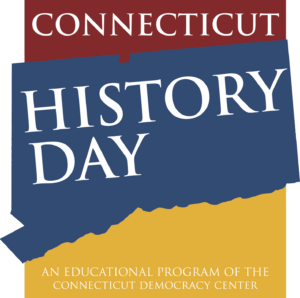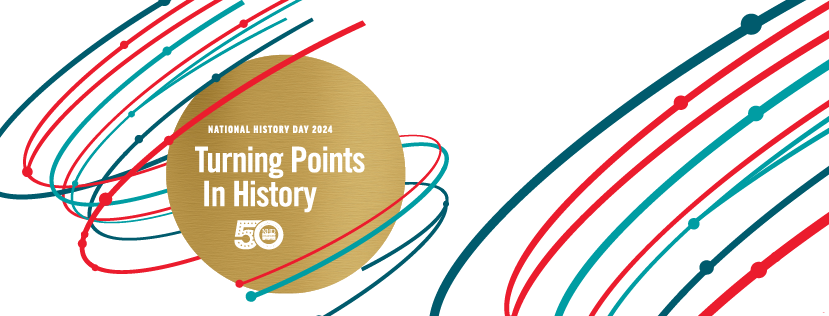The 2024 theme for Connecticut History Day, “Turning Points in History,” often brings to mind change and moments of pivot. Sometimes a turning point is obvious in the moment while other times it takes years, decades, or even centuries to realize something was a turning point. Connecticut has a history rich with stories of turning points in history—from events to ideas to actions—that cause change.
Events as Turning Points
 Most people think of turning points as an event or moment in time, after which the circumstances are altered. Some moments are known nationwide—like the ratification of the 19th Amendment to the US Constitution, granting women the right to vote. Other turning points are more state or locally specific. The 1965 Connecticut Education Amendment, for example, guaranteed free public education to every Connecticut child, setting the stage for prominent subsequent lawsuits that established important precedents for students. There are even more turning points that occur in Connecticut but have national (and even worldly) significance. The ruling of Griswold v. Connecticut set a crucial national precedent—a constitutional right to marital privacy—and became the turning point for future rights such as abortion rights, marriage rights, and more.
Most people think of turning points as an event or moment in time, after which the circumstances are altered. Some moments are known nationwide—like the ratification of the 19th Amendment to the US Constitution, granting women the right to vote. Other turning points are more state or locally specific. The 1965 Connecticut Education Amendment, for example, guaranteed free public education to every Connecticut child, setting the stage for prominent subsequent lawsuits that established important precedents for students. There are even more turning points that occur in Connecticut but have national (and even worldly) significance. The ruling of Griswold v. Connecticut set a crucial national precedent—a constitutional right to marital privacy—and became the turning point for future rights such as abortion rights, marriage rights, and more.
Often, horrible events become turning points for change and justice. While LGBTQ+ activists had been active in Connecticut for decades, the 1988 murder of Richard Reihl—a gay man from Wethersfield—galvanized and mobilized activists to demand LGBTQ+ civil rights. The activism contributed, in large part, to the passage of Connecticut’s 1991 Gay Rights Law—a turning point in its own right for future LGBTQ+ legislation.
Innovations Creating Turning Points
The creation of new inventions and ideas cause change and therefore spur their own turning points. While he could not have realized its significance at the time, Eli Whitney’s invention of the cotton gin became a turning point for the institution of slavery in the United States. While born in Connecticut, Whitney’s invention dramatically increased the South’s need for labor to pick and process cotton, making the region even more dependent on slavery and helping bring about the Civil War.
Turning points can continue to affect how society operates into the present and future. In 1878, the Boardman Building in New Haven became the site of the world’s first commercial telephone exchange, forever changing how communication and long-distance commercial operations worked. While Hartford’s Samuel Colt is known best for his firearms, his employees developed a manufacturing process that eliminated the variability of hand production—a turning point for the mass production of many manufactured items that we enjoy today.
Turning Points for Individuals and Communities
Turning points do not have to impact everyone in the world; communities or even individuals can experience their own turning points that influence the rest of their lives. During the Revolutionary War, for example, Norwich’s Benedict Arnold created a personal turning point when he decided to betray and abandon the Continental army to fight for the British—altering his life forever. Over a century later, during a different war (WWII), many women joined the workforce outside of the home to replace the men who left their jobs to fight in the military. Even though companies laid off many women when the war was over, the experience redefined women’s societal roles and ability to pursue work outside of the home.
Occasionally, turning points can cause the growth or decline of communities. Even though leaders Bobby Seale and Erika Huggins walked away with all charges dropped, the New Haven Black Panther trials were a pivotal point of decline in support for the Black Panther Party. Alternatively, while receiving federal recognition in 1994 reaffirmed the independence and sovereignty that the Mohegan Tribe had held for generations, it opened them up to the benefits and privileges of federal status. At the time, Mohegan Tribal Chief, G’tinemong/Ralph W. Sturges, acknowledged the turning point, commenting, “We are no longer the little old tribe that lives upon the hill. We are now the Nation that lives upon the hill.”
So whether you choose to focus on events, ideas, or actions, Connecticut’s history provides numerous examples of stories to help you in your search for a local topic that addresses the varied aspects of “Turning Points in History.”
We designed this Connecticut History Day page to help you find the perfect topic and connect you to the sources you need to get your project started. If you have any questions, we’re here, just ask. Happy exploring!








